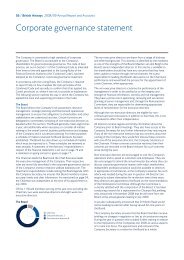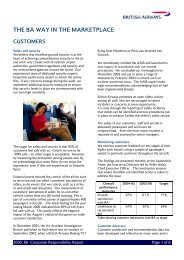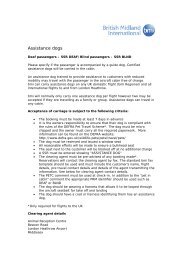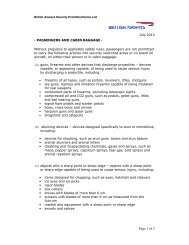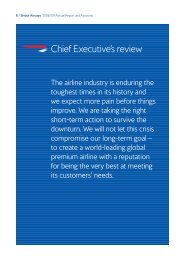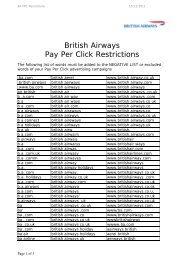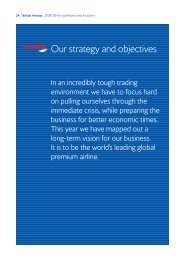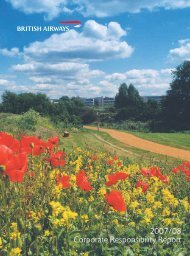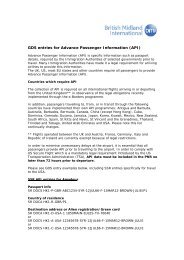Environmental Overview - British Airways
Environmental Overview - British Airways
Environmental Overview - British Airways
Create successful ePaper yourself
Turn your PDF publications into a flip-book with our unique Google optimized e-Paper software.
<strong>Environmental</strong> <strong>Overview</strong>2006 / 2007
Aviation is an essential part of the modern world, delivering social and economic benefits to diverse areas rightacross the globe through tourism, business travel and the sharing of knowledge and experiences. Equally, weare aware of the negative effects that flying can have on the environment and local communities. Weacknowledge our impact on the environment openly and honestly and actively work to minimise that impact.<strong>Environmental</strong> considerations are at the core of everything we do. That's why we've been reporting ourenvironmental performance since 1992, the first airline to do so.We have led the aviation industry for the last seven years in promoting carbon trading, and are the onlyairline in the world to have participated in carbon trading through the UK's voluntary scheme. We were alsothe first airline to enable its customers to offset their flight emissions. We invest in research, exploiting newtechnologies and expertise in order to address environmental challenges.Through improvements in fuel efficiency we have already cut our carbon dioxide emissions by 60 milliontonnes since 1990 – nearly four times our annual carbon emissions. We have consistently set the standard forenvironmental awareness and we are committed to continuing our work on improving our energy efficiency.We have been involved in the creation of our new home in Terminal 5 to ensure that it is energy and waterefficient, maximises recycling potential and minimises waste production.We will continue to keep you informed about our progress and our broader approach to our responsibilities,but in the future we will move away from printing these reports, towards a more environmentally friendlyformat online as part of our shift towards doing the majority of our business on ba.com.0203
NoiseWe are very aware of the noise impact our aircraft can have on local communities,particularly those close to our busy London hubs at Heathrow and Gatwick. Ourcontinuing efforts to minimise these effects are centred around two key areas; furtherinvestment in quieter aircraft and the development of better operating procedures.Thanks to these actions, we have halved the noise impact of our aircraft since 1998.Indicators of our noise performance, for example keeping to minimum noise routings atHeathrow and Gatwick, also show that we are once again amongst the best performers.To use another benchmark, our entire fleet is compliant with international ‘Chapter 3’ noisestandards with 87% also meeting the criteria for the most stringent ‘Chapter 4’ standard.As well as ensuring that our aircraft are amongst the lowest noise polluters, we have alsobeen active in the development of an arrivals code of practice. For example, 95% of ourarrivals into Heathrow use the quieter Continuous Descent Approach (CDA) procedure,a figure that is consistently above the airport average for this practice.CDA involves a steady descent from around 6,000 feet rather than a seriesof steeper stepped descents. This procedure has been shown to be theoptimum low noise procedure where airspace and safety considerations allow.Holding stack >Bottom of stack approx. 6000ft. >Continuous descent approach >< Normal approachRunway< Minimum ILS joining height 2500ft. (2000ft. LGW)< 3 deg.We are also investigating the potential for optimising CDA using equipment alreadyavailable on our aircraft. This would improve arrival procedures and minimise noisedisturbance for local communities.Following on from the success of CDA, we are now chairing a new group to look at thepotential for a similar code for departing aircraft.Total noise energy from <strong>British</strong> <strong>Airways</strong> aircraft(million ‘Quota Count’ equivalents)1.05 0.89 0.70 0.57 0.53 0.53 0.51 0.52 0.5498-99 99-00 00-01 01-02 02-03 03-04 04-05 2005 20060607
Local Air QualityLess waste, more recyclingWe recognise the impact that emissions from our aircraft and associatedground operations can have on local air quality and we have been activelyseeking to reduce them for a number of years.Waste management continues to be a priority area for our environmental programme.The challenge is to manage a complex range of wastes generated by a variety ofbusiness activities.We were involved with the Project for the Sustainable Development forHeathrow (PSDH). <strong>British</strong> <strong>Airways</strong> made a significant contribution to thefinal report of the Airport Air Quality Technical Panels that was publishedlast year, which was concerned with modelling air quality around the airport.In order to further assess our impact on the local environment, our newLocal Air Quality Key Performance Indicator (KPI) now includes calculatedoxides of nitrogen (NO x ) aircraft emissions emitted below 1,000 ft(currently Heathrow only).Our aim is to reduce waste at source, but where this is not possible the priority is tofind ways to re-use it, whether in whole or part. We are committed to recycling anyremaining waste, with an overall goal of reducing our reliance on landfill for finaldisposal. As technology and facilities become available, we will explore the use ofincineration with energy recovery or composting as methods to avoid disposal to landfill.Such efforts are having significant results, with figures showing that the total amountof waste handled by our waste management contractor at Heathrow and Gatwickhas decreased by 9% compared to last year. Overall, there is a 6% improvementyear-on-year in the waste per passenger at Heathrow and Gatwick and we currentlyrecycle 28% of our solid waste at these airports.Total NO x emissions from <strong>British</strong> <strong>Airways</strong>aircraft operations below 1,000ft atLondon Heathrow Airport (tonnes)941 1003 1041 1080 1096Our principal aims of reducing waste at source and recycling all possible unavoidablewaste have resulted in a 10% decrease in the amount of waste going to landfill fromHeathrow and Gatwick in comparison with the previous year. By 2010 we aim to berecycling 50% of our waste and sending none to landfill.To maximise our recycling potential we have also formed a group to focus on therecycling of materials provided as part of the catering product and associated in-flightservice. On top of this, we have recently launched a project to recycle newspapersfrom shorthaul flights arriving into Heathrow.2002-3 2003-4 2004-5 2005 2006Recycling opportunities come in many different guises. For example, we have establisheda new worldwide furniture management contract that promotes the re-use and recyclingof our office furniture, which will help to promote our principal aim of avoiding waste tolandfill. We continue to seek opportunities to source recycled material and have recentlyintroduced recycled paper to all of the office printers in the UK. This allows us to protectthe environment as both a recycler and a purchaser of recycled products.The NO x below 1,000 foot indicator shows an increasing trendbecause of increased utilisation of our aircraft. To counter thiswe have plans to invest in new more efficient aircraft with loweremissions. Also, we are constantly reviewing our operational proceduresand assessing the effects of different practices to reduce emissions.We also recognise water as a precious commodity and we routinely monitor our waterconsumption wherever possible. Through careful consideration we managed to achieve a2.5% reduction on water consumption at our London hub airports of Heathrow and Gatwick.There are ways in which we can reduce aircraft emissions on the groundas well as in the air. We have recently conducted a review to investigatethe emissions reductions and fuel savings available through aircraft taxiingto the terminal with one engine shut down. Approximately 50% of ouraircraft now use this procedure, up from 20% last year.Last year, we completed our fourth year of Nitrogen Dioxide (NO 2 )monitoring to the north of Heathrow Airport. <strong>British</strong> <strong>Airways</strong> hasbeen the only airline to carry out monitoring in this way and withlocal councils and the BAA, have published the results. Seewww.heathrowairwatch.org.uk for further information.Waste Management Methods 2006LHR & LGW TonnesLiquid Treatment 5,895Landfill 4,063Recycled 1,490Liquid Recovery 227Incineration 160N.B. Does not include waste managed bycatering suppliers or airport companies0809
Making a differenceA new home for a new eraAs well as protecting communities and the environment at home, we also havea global support network that reaches out to many distant countries and causes.Since 1984, the <strong>British</strong> <strong>Airways</strong> Community Relations programme has offeredassistance to community and conservation projects around the world. Oursupport enables these projects to redirect crucial funds towards essentials suchas equipment, education and sustainable development for the benefit of theenvironment and/or host community.We actively support 130 community and conservation organisations worldwide,providing more than 1,000 tickets each year. These organizations are also ableto benefit from excess baggage waivers and free cargo space.In 2006 <strong>British</strong> <strong>Airways</strong> was awarded The Travel & Leisure Global Vision Award“In recognition of an organisation that is defending the cultural, ecological andhistoric treasures of the traveller’s world”.Some of our partners include:The Uganda Conservation Foundation, which works on a number of conservationprojects including the “Elephants, Crops and People” project.The Mountain Gorilla Conservation Fund, which is dedicated to ensuring the future ofthe Mountain Gorillas of Rwanda, Uganda and the Democratic Republic of the Congo.Fauna & Flora International, which works to conserve threatened species worldwide,choosing solutions that are sustainable, based on sound science that take account ofhuman needs.The £4.3 billion state-of-the-art airport terminal, which officiallyopens to customers on March 27 2008, will offer unrivalledopportunities for <strong>British</strong> <strong>Airways</strong> to provide one of the mostmodern efficient airport facilities in the world.Environment is at the heart of the design and construction of T5,and will continue to be an integral part of its operation.<strong>Environmental</strong> action plans have been developed to manage keyissues and meet the environmental planning conditions and publicinquiry commitments.These plans include:• Investing £25 million in new vehicles and equipment to bedelivered by March 2008. All vehicles are to the latest exhaustemission standards including 38 new buses to the future Euro 5emission standard.• Stricter start up and shut down times for the Auxiliary PowerUnit (APU*), which will improve <strong>British</strong> <strong>Airways</strong>’ noiseperformance and reduce carbon dioxide emitted.• Recycling 85% of <strong>British</strong> <strong>Airways</strong>’ construction waste andcontinuing to develop innovative ways of managing<strong>British</strong> <strong>Airways</strong>’ waste during operation.• Sourcing all timber used in <strong>British</strong> <strong>Airways</strong>’ facilities fromsustainably managed sources.• Using a combination of non-potable water from rainwaterharvesting and ground water to reduce the demand on the publicwater supply by 70%.• Using waste heat from the existing airport heat and power stationto supply 85% of T5’s heat demand. Building managementsystems will ensure the most efficient energy usage in T5.*An APU is a small engine located in the tail of an aircraft used to generate electricalpower and supply air conditioning to the aircraft cabin whilst it is on the ground.Case Study: Use of ForestStewardship Council (FSC) timber.In our lounges we have used oak and pear wood fromMehling and Wisemann, in Germany. The wood is FSCaccredited, from the Spessart region of Northern Bavaria.The wood has been smoked and stained to give it a darkerappearance using a process designed to have a neutralimpact on the local environment. The factory produceszero waste and unusable timber off-cuts from the processare used to provide heat and hot water in the factory.For more information on the projects that we support, please click on the mapon the Globally tab of our website www.ba.com/communityrelationsThe <strong>British</strong> <strong>Airways</strong> Community Learning Centre enables children to learn aboutour environment in the 240 acres of Harmondsworth Moor Parkland adjacentto our Head Office. Primary, secondary and special educational needs schoolsaround Heathrow are able to explore various habitats such as meadows, riversand woodland as part of a range of environmental education programmes thatwe offer. All programmes are cross curricular and develop key educational skills.Local Community groups can also benefit from the Learning Centre by participatingin programmes that focus on flight and the environment.Case Study : Harmondsworth MoorHarmondsworth Moor country park surrounds<strong>British</strong> <strong>Airways</strong> corporate headquarters near Heathrow.Comprising 240 acres of reclaimed land that had beenneglected for many years, the park is now host to diverseflora and fauna. Fully open to the public, the park ismanaged to encourage both public usage and biodiversity. In recognitionof its commitment to biodiversity at Harmondsworth Moor, <strong>British</strong> <strong>Airways</strong>is one of four companies to have been awarded the Wildlife Trusts prestigiousBusiness and Biodiversity Benchmark award as well as the Civic Trust’s GreenFlag award, the national standard for parks and green space maintenance andmanagement.1011
Registered Office: Waterside, PO Box 365, Harmondsworth UB7 0GBRegistered Number: 1777777




